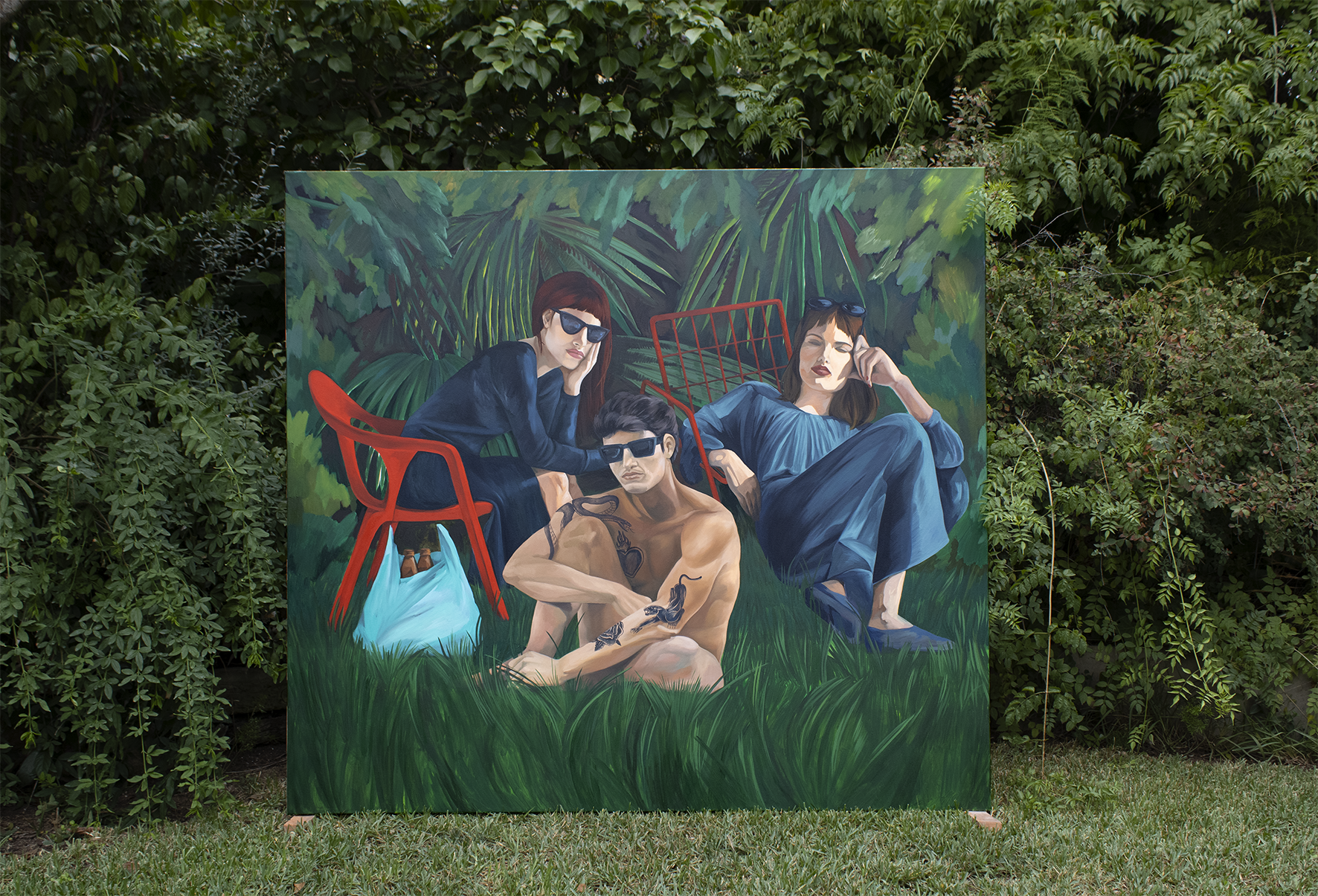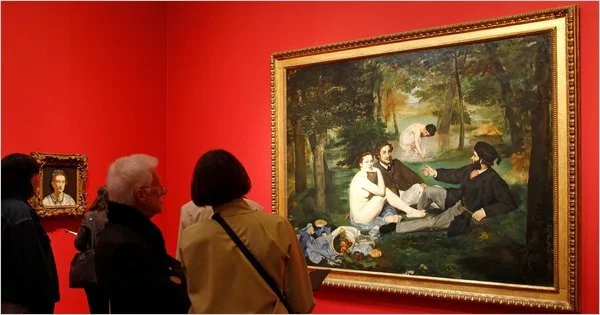Déjeuner sur l’herbe à Valencia. 2025
Reinterpretation of the work Le Déjeuner sur l'herbe (1863), by Édouard Manet. 185 x 170 cm. Oil and acrylic on linen.
This piece is part of a series of paintings that aim to reinterpret iconic works from Art History by placing them in a contemporary context. In Art History, certain scenes are repeated cyclically, and when reimagined in a modern setting, they allow us to observe changes in our social behavior. The poetics of reinterpretation seek to establish a dialogue between long-gone artists and those of today, and in this attempt, a kind of "failed act" occurs. However, even though this “dialogue” is not retroactive in nature, it creates a constantly evolving connection between the past and the present — thus granting the viewer the ability to connect with both that past and their present in order to form their own reinterpretation.
( ESP ) Esta pieza pertenece a una serie de pinturas que tienen como intención reinterpretar obras emblemáticas de la Historia del Arte llevándolas a un contexto actual. En la Historia del Arte se repiten escenas que son cíclicas, y que llevadas a un contexto contemporáneo nos permiten observar cambios en nuestro comportamiento social. La poética de la reinterpretación intenta establecer un diálogo entre los artistas ya desaparecidos y los actuales, y en esta intención se da el acto fallido. Pero a pesar que este “diálogo” no es de carácter retroactivo, se genera una conexión en constante evolución entre el pasado y el presente. Otorgando así, al espectador, la capacidad de conectar con ése pasado y su presente para su propia reinterpretación.
"Luncheon on the Grass" by Édouard Manet is an analysis of modern art that challenges academic conventions by realistically depicting a modern, nude woman. Manet submitted the work to the Paris Salon of 1863, but it was rejected for defying artistic norms and the expectation that artworks should depict historical or mythological scenes.
The main source of controversy was the presence of a nude woman in a modern, everyday setting—a practice that was not tolerated in academic art. This nudity was a taboo subject, considered inappropriate for painting.
Some studies suggest that the work represents the prostitution that was prevalent in Paris at the time, or the woman's submissive position in relation to men.
Although the composition can be seen as a reference to classical works such as Titian’s Pastoral Concert, Manet reinvents it by presenting a group of modern Parisians, marking a break between the past and the present.
By presenting a common subject like a picnic on a large-scale canvas, Manet validated the mundane and opened the door for other Impressionist artists to explore similar themes.
(ESP) “El almuerzo sobre la hierba" de Édouard Manet es un análisis del arte moderno, que desafía las convenciones académicas al presentar a una mujer moderna desnuda de forma realista. Manet presentó la obra al Salón de París de 1863, pero fue rechazada por desafiar las normas artísticas y la expectativa de que las obras deben representar escenas históricas o mitológicas.
La principal fuente de controversia fue la presencia de una mujer desnuda en un entorno moderno y cotidiano, una práctica que no se toleraba en el arte académico. Esta desnudez era un tema tabú, impropio de una pintura.
Algunos estudios sugieren que la obra representa la prostitución que prevalecía en el París de la época, o la mujer en posición de sumisión ante los hombres
Aunque la composición puede ser vista como una referencia a obras clásicas, como el "Concierto campestre" de Tiziano, Manet la reinventa presentando un grupo de parisinos modernos, marcando una ruptura entre el pasado y el presente.
Al presentar un tema tan común como un picnic en un lienzo de gran tamaño, Manet validó lo mundano y abrió la puerta para que otros artistas impresionistas trataran temas similares.
Visitors at the Musée d’Orsay in Paris view Manet’s “Déjeuner sur l’Herbe.” Parisians first encountered the painting around the time it was notoriously rejected from the annual Salon in 1863. Credit: Benoit Tessier/Reuters.
In Déjeuner sur l’herbe à Valencia (2025), the canvas breathes life into a scene set in a Valencian garden, where the morning light emerges from a sleepless night. The hours stretched on, as music and laughter gave way to wandering streets, intimate conversations, and the soft arrival of dawn.
Two women, perhaps artists or designers, or maybe the bold CEOs of a nascent startup, converse at ease beside a young man, his nakedness as natural as the city around them. They might be in El Parque de Cabecera, or perhaps Parque Central, after the last whispers of a Ruzafa bar had faded and they’d grabbed litronas from a corner shop. Or they could be wandering the old Turia riverbed, heading toward the beach where the sunrise in El Cabañal ignites the sky in colors too vivid for words.
(ESP) En Dejueneru sur l'herbe a Valencia se presenta una escena en un jardín valenciano.
Una escena bastante habitual en las costumbres valencianas contemporáneas. Un amanecer sin dormir. La noche se alargó, después de la música y los bares llegaron los paseos, las conversaciones y, el amanecer. Dos mujeres, posiblemente artistas visuales, diseñadoras o, quizás, CEOs de alguna empresa startup mantienen una conversación relajada junto a un joven desnudo que las acompaña. Seguramente se encuentren en El Parque de Cabecera, o quizás en el Parque Central después de cerrar algún garito del barrio de Ruzafa tras haber cargado con las litronas en algún bazar paquistaní. O simplemente pararon a descansar en el antiguo cauce del Río
Túria de camino a la playa, el amanecer en el Cabañal es espectacular.





